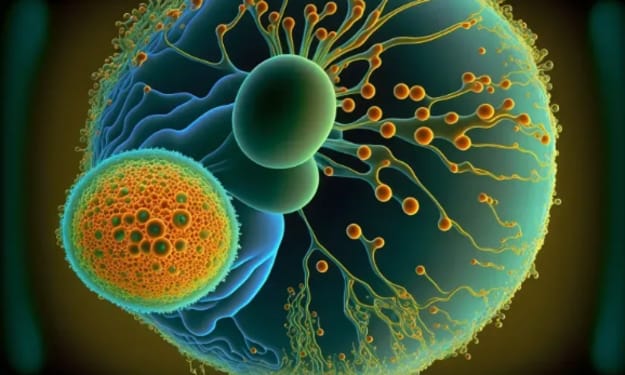
“I was shaken from my stupor of staring out at the yellow dot growing minutely larger in the distance,” Ahmad began, “when I heard the person floating to my right ask, ‘I wonder what it would be like to take a walk outside?’ Turning toward him, I peered at the man who had just spoken. Blinking to regain my focus, I blurted out, ‘Excuse me, what?’ not sure I had caught his words correctly.
“To my great surprise, I found I did not recognize the fellow at all. Under his bright, single-colored dashiki and matching pants combination, all I could tell was that he was dark-skinned, clean-shaven, and amazingly—despite several months of drifting in microgravity—still noticeably muscular.”
“Oh, Ahmad,” Durojaiye teased, “I did not know you were looking at me so intently. I am blushing now!”
“That is not what I meant!” Ahmad said in defense of his description.
Undeterred, Durojaiye kept it up. “Not that Ahmad ever had a muscle tone to speak of to lose, so he must have been jealous!”
“Ah, I cannot help that I have always been a rounder person, no matter what lifestyle I have led,” Ahmad claimed. “It must be genetic! And I think you are looking at me wrong, as I am the right size for my height. I just look bigger because of it.”
Lilit could not resist and said, “Well, the good news is that being back in microgravity has helped you gain a couple of centimeters!”
Missing the joke entirely, Ahmad agreed, “Yes, quite so. But let me tell you something: even for someone from the unnamed sand dunes on the outskirts of the United Arab Emirates, I am, sad to say, somewhat short.”
“But Durojaiye is not that much taller than you,” Lilit observed from her stature, which was almost a full head above both of them.
“I just wear it better with my glorious musculature,” Durojaiye offered.
“Anyway,” Ahmad said, attempting to take back the reins. “Putting all that together with his accent, I deduced that the man previously unknown to me must have been of Nigerian origin.”
“You did no such thing!” Durojaiye accused. “You are adding facts to the past with things you learned at a later point.”
“That is slander!” Ahmad cursed. “And I confirmed it when I heard your name. You said in your typical clipped, but perfectly pronounced English, ‘Oh, pardon me, I did not realize I had spoken out loud. Ah, I do not believe we have met! Many apologies, my friend, please allow me to introduce myself.’ And then you gave a proper introduction. At that moment I thought that yes, I was spot on. With a name like that, you were definitely Nigerian.”
“You will notice, Lilit,” Durojaiye interposed, “that Ahmad has admitted that I gave a proper introduction, but said nothing about himself. He was quite rude, but I am happy that he has confessed this himself so I did not have to bring it up.”
Aghast, Ahmad jumped right in saying, “Per usual, you mispresent what was happening and leave out pertinent details! My lack of respectful greeting at that moment was because as you held out an open hand with an offer of a handshake in the Western style, horror overcame me.”
“Right,” Durojaiye agreed, “you hesitated for a moment, concerned about what type of microbes could be growing on this unfamiliar weirdo after we had all been confined so long to the ship.”
“No, no, that was not it,” Ahmad protested. After Durojaiye stared at him for a number of seconds without saying a word, he said, “Okay, maybe it was a little. However, I decided it would be ill-mannered of me to not accept your invitation and took your hand firmly in my own. But that is when my terror took hold and made me still my tongue. Much to my chagrin, you released your hold on the safety straps attached to the full-length windows in front of us.”
“Here we go...” Durojaiye trailed off. Lilit realized that he had undoubtedly heard this contention dozens of times before, probably even more so since this journey had begun.
Appearing not to notice the comment at all, Ahmad ranted, “We had been given strict instructions to never let go of the clutch-devices lest we go flying out of control and break something or injure ourselves or someone else. As such, I gripped on to my own strap out of concern for both of our precious and irreplaceable lives, solidly holding your palm so that you would not sail away due to the momentum from our greeting.”
“Now we’re getting somewhere!” Lilit encouraged Ahmad in an attempt to hasten the story along.
“Yes, well,” stuttered Ahmad, “I continued to hold on tight as I introduced myself with all the proper—I repeat, proper—politeness. I said, ‘It is odd that although there are only a few thousand people on this transport, I do not believe I have ever seen you before.’ To that, my dear friend here announced that it may be because he generally kept his own personal time.”
Lilit thought about that odd phrasing for a moment. From her understanding, back on Earth, the clocks in different geographic regions were set according to the hours that were most reasonable for their vicinity. Of course, this had been greatly complicated by the advent of the colonization of other worlds. On Earth’s moon Luna, for instance, it was daytime for about two weeks and then nighttime for around the same time. Meanwhile, on Mars, a sol was roughly thirty-nine and a half minutes longer than a typical Earth-day. That bit of extra time each rotation did not seem like much, but it quickly became evident that throwing off natural circadian rhythm even a small amount created many adverse and debilitating health effects for all Earth-originating life.
In the end, because people living on Luna, Mars, the dwarf planetoid Ceres in the Asteroid Belt, and other similar places had to live underground in order to avoid the deleterious impacts of solar radiation, they all ended up going back to a twenty-four-hour based clock anyway and picked a time zone comparable to one back on Earth. Usually this was the area that most people came from—or, more likely, the one that the monetary sponsors originated from despite the fact that the generally poorer laborers outnumbered them twenty-to-one. That was exactly what had happened with Aestas, too, in the distant past. Consequently, that was the same chronometer they were now keeping aboard this craft. Being a native-born citizen of the colony, Lilit had no idea what part of the Earth shared the hours she had grown up with and lived in her whole life—aside from that one regrettable experience she was still trying to put behind her.
Similarly, Lilit surmised, the ship Ahmad and Durojaiye had originally left from Earth on more than five years prior probably maintained an internal clock based upon its point of origin on the ground. The interplanetary transport that carried them was a dedicated ferry, going back and forth from Tsiolkovsky-Pearson Station at the end of the space elevator above Volcán Cayambe in Puerta Estrella, Ecuador—one of the few Earthly locations Lilit knew and could point to on a map—to a receiving platform in orbit around Venus. The Terran Government had made it abundantly clear they considered her own homeworld to be second rate, so no one would have a ship that matched up to Venus’s time. At least, that was not the case until her and her team’s most recent... acquisition.
After leaving Earth, Ahmad’s and Durojaiye’s final destination was, of course, her birthplace: Aestas, the first of the planned soaring sky-cities above Venus’s hellish surface. Named after the Roman goddess that is the personification of Summer, Aestas was basically a dirigible filled with an Earth-like atmosphere that allowed it to stay aloft in Venus’s much denser “air”. To the disbelief of many Earthers, Mars had proven to be highly resistant to every terraforming effort HSA—the Human Space Agency—had thrown at it. Thus, an early twenty-first century proposal called “Project HAVOK” from HSA’s ancient predecessor organization NASA was revived with the idea of putting floating habitats on Venus.
While the pressure on the surface of Venus was almost a hundred times that of Earth and the temperature could reach a blistering 738°K—hot enough to melt lead—that was not true higher up above the clouds. There, the pressure was more tolerable and it was far cooler. Although still too hot to handle, it was well within the range of even twenty-first century refrigeration technology to cool the interior of an object residing at that level in the stratosphere.
More importantly, Venus had an induced magnetic field to protect it from the solar radiation that kept the denizens of places like Luna and Mars from seeing the sun for but a scant few hours a month. And most of all, the gravity was ninety percent that of Earth, a difference that was barely noticeable. Gravity and magnetic fields had been found to be the key factors in keeping Earth-based-beings alive, healthy, and functional. As such, it was a constant struggle in places that lacked them, which was basically everywhere else.
However, this was not the case with Aestas, a metropolis that now thrived with hundreds of thousands of people. The city actually propelled itself across the terminus line where the sun met the darkness, creating a twenty-four-hour-ish “normal” cycle. Lilit’s people lived on its solid platforms, grew food and trees under a visually-larger sun, and had a perpetual summertime thanks to the city’s movements and the general conditions of Venus. It was as close to freely living on the surface as any of the colonies got.
Compared to almost all other planets in the Sol System, Venus spun in the opposite direction—retrograde, albeit very slowly, with a sol on Venus lasting even longer than its full rotation around the sun—perhaps because some other large terrestrial object slammed into it in the distant past. And unlike Earth’s and Mars’s highly angled axial tilts and elliptical orbits, Venus stood nearly straight-up as it circumnavigated the sun in an almost perfect circle. All these factors made it so Aestas’s environmental and navigation systems could more easily create and maintain a true paradise.
Really, Lilit thought, Ahmad’s and Durojaiye’s ferry should have used the same hours as Aestas. It would have made so much more sense to synchronize up with the local time at their destination over the course of their long three-and-a-half-month journey between worlds instead of having a sudden shift when they finally arrived. Still, although prior to meeting these two she had never left her planet, even she knew that it was odd—to say the least—to find someone who was living on their own personal clock, especially at that point in their voyage.

The above piece is an excerpt from the speculative hard science fiction novel Aestas ¤ The Yellow Balloon by J.P. Prag, available at booksellers worldwide. Learn more about the author at www.jpprag.com.

As humanity begins to tame the stars above, at what point do a group of colonists turn into a unique, indigenous people who will band together to protect their homeland... no matter what?
Lilit Sarkisian was an average young woman who made a living welcoming new immigrants to the floating city of Aestas, soaring high above the clouds on Venus. Then, one day, she met her new clients Ahmad Al Zaheri and Durojaiye Yakubu. From that moment onward, her life irreparably changed and forever altered the course of the place she had always known as home. Somehow, these two became her best friends in the whole universe, and her most loyal coconspirators.
Aestas appeared to be a successful colony, much more so than places like Mars where terraforming had ultimately failed. Yet the powers-that-be, both on Venus and Earth, refused to do anything to alleviate the pressures caused by its exploding population. To fully resolve these issues, Lilit found herself evolving from an unknown civil servant to the leader of a revolution to a dangerous interplanetary symbol. Her story did not end there, though, nor did the machinations of those who had other plans for her birthplace.
With the help of her most trustworthy companions Ahmad and Durojaiye, was Lilit able to save the irreplaceable Venusian society from forces far more powerful than her?

Aestas ¤ The Yellow Balloon is a work of mixed fiction and nonfiction elements. With the fiction elements, any names, characters, places, events, and incidents that bear any resemblance to reality is purely coincidental. For the nonfiction elements, no names have been changed, no characters invented, no events fabricated except for hypothetical situations.
About the Creator
J.P. Prag
J.P. Prag is the author of "Aestas ¤ The Yellow Balloon", "Compendium of Humanity's End", "254 Days to Impeachment", "Always Divided, Never United", "New & Improved: The United States of America", and more! Learn more at www.jpprag.com.






Comments
There are no comments for this story
Be the first to respond and start the conversation.